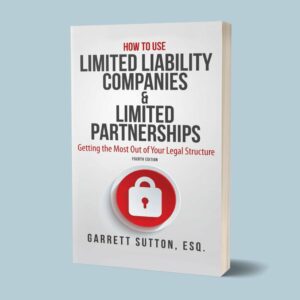Advantages of Limited Partnerships
- LPs allow for pass-through taxation for both the limited partner and the general partner.
- Limited partners are not held personally responsible for the debts and liabilities of the business, although the GP, if an individual, may be personally responsible.
- The general partner(s) have full control over all business decisions, which can be useful in family situations where ownership – but not control – has been gifted to children.
- Estate planning strategies can be achieved with LPs.
- Limited partners are not responsible for the partnership’s debts beyond the amount of their capital contribution or contribution obligation. So, unless they become actively involved, the limited partners are protected.
- As a general rule, general partners are personally liable for all partnership debts. But as was mentioned above, there is a way to protect the general partner of a limited partnership. To reduce liability exposure, corporations or LLCs are formed to serve as general partners of the limited partnership. In this way, the liability of the general partner is encapsulated in a limited liability entity.
- Because by definition limited partners may not participate in management, the general partner maintains complete control. In many cases, the general partner will hold only 2% of the partnership interest but will be able to assert 100% control over the partnership. This feature is valuable in estate planning situations where a parent is gifting or has gifted limited partnership interests to his children. Until such family members are old enough or trusted enough to act responsibly, the senior family members may continue to manage the LP even though only a very small general partnership interest is retained.
- The ability to restrict the transfer of limited or general partnership interests to outside persons is a valuable feature of the limited partnership. Through a written limited partnership agreement, rights of first refusal, prohibited transfers, and conditions to permitted transfers are instituted to restrict the free transferability of partnership interests. It should be noted that LLCs can also afford beneficial restrictions on transfer. These restrictions are crucial for achieving the creditor protection and estate and gift tax advantages afforded by limited partnerships.
- Creditors of a partnership can only reach the partnership assets and the assets of the general partner, which is limited by using a corporate general partner which does not hold a lot of assets.
- The limited partnership provides a great deal of flexibility. A written partnership agreement can be drafted to tailor the business and family planning requirements of any situation. And there are very few statutory requirements that cannot be changed or eliminated through a well-drafted partnership agreement.
- Limited partnerships, like general partnerships, are flow-through tax entities.
For more information on this topic, get the book!
Case Study:
When a Limited Partnership is Best
Jim is the proud father of three boys. Aaron, Bob, and Chris are active, athletic, and creative boys almost ready to embark upon their own careers. The problem was that they were sometimes too active, too athletic, and too creative.
At the time Jim came to see me, Aaron was seventeen years old and every one of the seemingly unlimited hormones he had was shouting for attention. He loved the girls, the girls loved him, and his social life was frenetic and chaotic.
Bob was sixteen years old and sports were all that mattered. He played sports, watched sports, and lived and breathed sports.
Chris was fifteen years old and the lead guitarist in a heavy metal band. When they practiced in Jim’s garage the neighbors did not confuse them with the Beatles.
Jim has five valuable real estate holdings that he wants to go to the boys. His wife had passed on several years before and he needed to make some estate planning decisions. But given the boys’ energy level and lack of direction he did not want them controlling or managing the real estate.
Jim knew that if he left the assets in his own name, when he died the IRS would take 55% of his estate, which was valued at over $10 million. And while estate taxes were supposed to be gradually eliminated, Jim knew that Congress played politics in this arena and no certainty was guaranteed. Jim had worked too hard, and had paid income taxes once already before buying the properties, to let the IRS’s estate taxes take away half his assets. But again, he could not let his boys have any sort of control over the assets. While the government could squander 55% of his assets, he knew that his boys could easily top that with a 100% effort.
I suggested that Jim place the five real estate holdings into five separate limited partnerships.
I further explained to Jim that the beauty of a limited partnership was that all management control was in the hands of the general partner. The limited partners were not allowed to get involved in the business. Their activity was “limited” to being passive owners.
It was explained that the general partner can own as little as 2% of the limited partnership, with the limited partners owning the other 98% of it, and yet the general partner can have 100% control in how the entity was managed. The limited partners, even though they own 98%, cannot be involved. This was a major and unique difference between the limited partnership and the limited liability company or a corporation. If the boys owned 98% of an LLC or a corporation they could vote out their dad, sell the assets, and have a party for the ages. Not so with a limited partnership.
The limited partnership was perfect for Jim. He could not imagine his boys performing any sort of responsible management. At least not then. And at the same time he wanted to get the assets out of his name so he would not pay a huge estate tax. The limited partnership was the best entity for this. The IRS allows discounts when you use a limited partnership for gifting. So instead of annually gifting $14,000 tax free to each boy he could gift $16,000 or more to each boy. Over a period of years, his limited partnership interest in each of the limited partnerships would be reduced and the boys’ interest would be increased. When Jim passes on, his estate tax will be based only on the amount of interest he had left in each limited partnership. If he lives long enough he can gift away his entire interest in all five limited partnerships.
Except for his general partnership interest. By retaining his 2% general partnership interest, Jim can control the entities until the day he dies. While he is hopeful his boys will straighten out, the limited partnership format allows him total control in the event that does not happen.
Jim also liked my advice that each of the five properties be put into five separate limited partnerships. I explained to him that the strategy today is to segregate assets. If someone gets injured at one property and sues, it is better to only have one property exposed. If all five properties were in the same limited partnership, the person suing could go after all five properties to satisfy his claim. By segregating assets into separate entities the person suing can only go after the one property where they were injured.
Jim liked the control and protections afforded by the limited partnership entity and proceeded to form five of them.
Is a Limited Partnership right for you? Get your free 15-minute consultation today!


